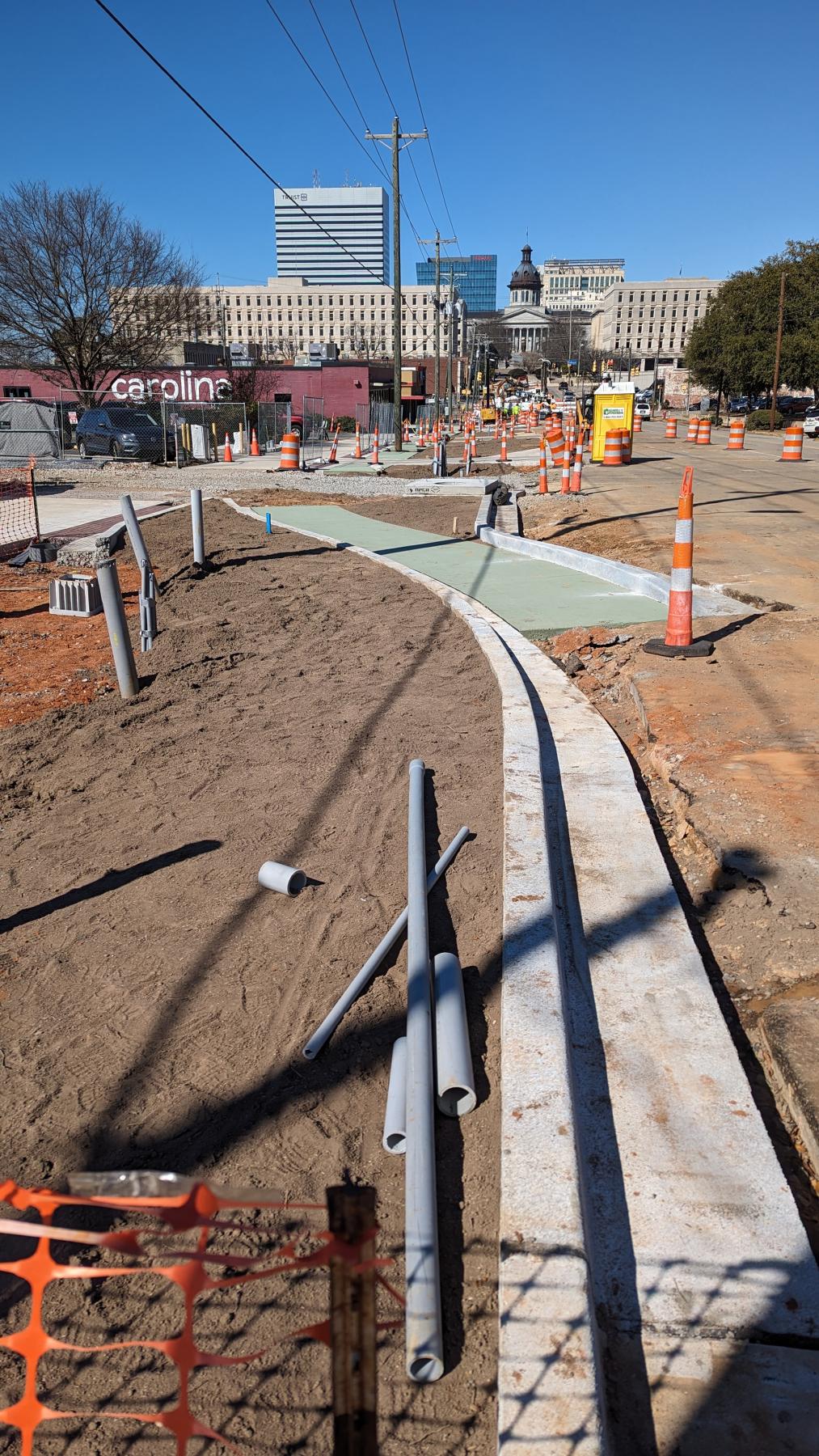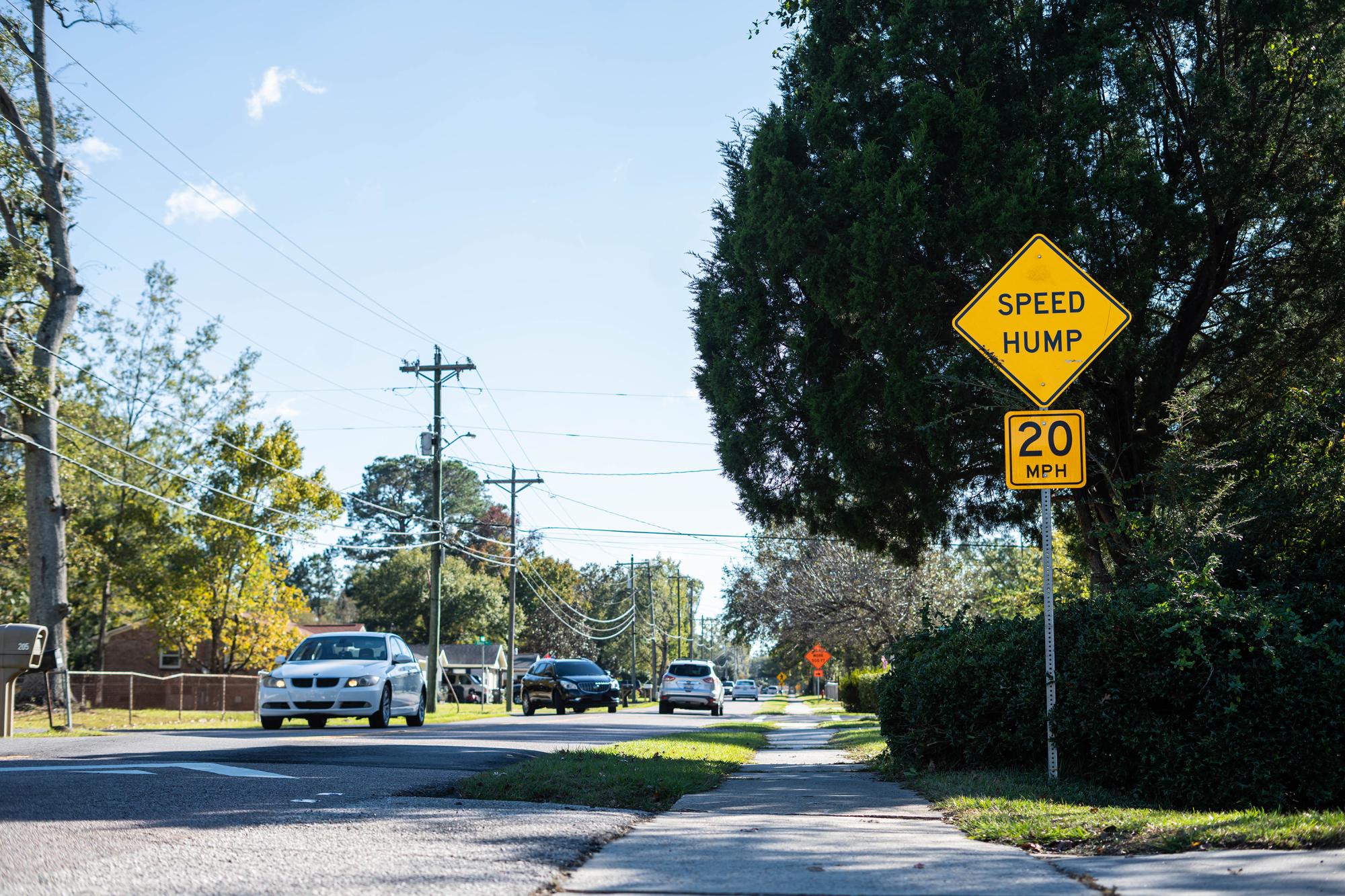From a pedestrian perspective, the issue of slowing vehicle traffic on roads can be a life-or-death consideration. The chance a pedestrian would survive being hit by a car traveling at 20 miles per hour is 95%. If the car is driving at 40 miles per hour when it strikes a pedestrian, the survival chance is reduced to 20%.
“It’s amazing how much of a difference it makes to have slower traffic in areas where you have more pedestrians,” said Lucinda Statler, planning administrator for the City of Columbia. “[Traffic calming] is critically important for the safety of our users and to make people feel safe so that they’ll be willing to walk more places.”
As communities grow and residents and visitors look for more options to walk and bike, cities and towns are tackling ways to slow the vehicles driving through business districts and neighborhoods.
In Columbia, housing is popping up around the downtown area and more than 30,000 students now attend the University of South Carolina, making the city more densely populated.
“We are trying to become more multi-modal, especially in the denser parts of town where it makes sense,” Statler said. “That means providing facilities for pedestrians and cyclists.”
It’s a challenging issue. The City of Columbia is going through a downtown strategic planning process, partly focusing on how it manages its sidewalk space. Creating a more pedestrian-friendly environment involves providing more space for walkers and more trees. It also involves establishing bump-outs on curbs that make crossing at an intersection shorter, and providing a median or cutout on a wide street, offering a stopping place for pedestrians who don’t make it all the way through a busy intersection.
“It’s about helping connect the city at a pedestrian level so that people are not just able to walk, but want to walk,” she said. “And we don’t want you to feel like you’re having to play ‘Frogger’ when you are trying to cross a street.”
The process involves both small changes that private development can make and large streetscape projects, which, in Columbia, are mostly funded by the SC Department of Transportation and Richland County penny tax proceeds. The city works with those agencies to try to ensure that plans consider the city’s suggestions about creating a better pedestrian environment.
One of those projects that was recently completed in the city is the River Drive bike lane, which is the first buffered bike lane in Columbia. The project came about because of communication between the city and SCDOT, which gives the city a list of roads it plans to repave. River Drive, a thoroughfare that the city had targeted for a bike lane, was on the list to be repaved, and the early notice gave Columbia time to engage in public outreach and prepare residents for the changes that a bike lane in front of their homes can bring.
Much larger projects are also underway in the city, including major changes in the Five Points shopping and entertainment district, along with a transformation of South Main Street near the capitol and USC.
In Five Points, long-considered one of the more dangerous parts of the city for bicyclists and pedestrians, the number of lanes has been reduced to slow vehicles driving through the area, and brick medians have been placed to discourage people from crossing in the middle of the blocks. On Devine Street, traffic was reduced from four lanes to three between Saluda Avenue and Harden Street, while the main thoroughfare of Harden Street will change from four lanes to two between Devine and Blossom streets.
A few miles away on South Main Street, the four-lane road that ran from the State House through an area primarily made up of the USC campus to Blossom Street, is being changed to one lane in each direction along with a center turn lane. The project, which also included rebuilding underground utilities and moving the power lines below ground, leaves room for much wider sidewalks and a physically separated bike lane.
“That’s going to be a really nice streetscape right in front of the capitol and in the heart of the university,” Statler said. “It’s such a great opportunity from a location standpoint for pedestrians and for developments to have active frontages.”

While Columbia’s South Main Street has had its number of car lanes
reduced, it has gained wider sidewalks and a separated bike lane.
Other plans in the early stages include addressing the substantial width of pedestrian crossings on the heavily traveled Assembly Street. Statler said planners, the public and consultants have long agreed on the need for pedestrians to be able to safely cross Assembly, a main thoroughfare that separates downtown and the Vista entertainment district. One of Columbia’s busiest intersections, Gervais and Assembly streets, will be part of the new plans.
Years ago, Columbia partnered with the Central Midlands Council of Governments to create the Walk Bike Columbia master plan, which was adopted in 2015. The council of governments involvement lent a high level of legitimacy to the plan and allows for strong coordination with SCDOT for road projects in the city.

Goose Creek’s traffic calming efforts have included speed humps in
residential areas. Photo: City of Goose Creek.
In the City of Goose Creek, the Neighborhood Traffic Calming Program focuses on installing speed humps to slow vehicle traffic in residential areas, said Alexis Kiser, the city’s special projects manager.
“City council adopted the traffic calming measures program after feedback from our residents that certain neighborhoods have issues with speeding due to the street network creating cut-through roads,” Kiser said. “Staff began discussions with Berkeley County and [SCDOT], both of which own and maintain roads in the city, to learn how to create a policy that was in alignment with their current requirements for traffic calming measures.”
Neighborhood associations or groups of residents can complete an application request for a speed hump. If the road is maintained by SCDOT, 75% of the residents in the project area must sign a petition sheet for approval, while if the roadway is maintained by Berkeley County, 85% of residents in the area need to sign the petition. Privately maintained roads are not eligible for the program.
Kiser said traffic calming measures are essential for cities because they enhance road safety for cars and lower the risk and severity of accidents for walkers, cyclists and other drivers.
“They help create a more pleasant and livable environment by reducing noise and pollution levels in neighborhoods,” she said. “Additionally, traffic calming can encourage more walking and cycling, supporting community health and sustainability goals.”
Kiser said the reaction from the community has been positive, with several individuals and homeowners associations submitting requests for information and collecting the required signatures.
The City of Goose Creek funds the traffic calming measures program through the general fund with assistance from Berkeley County Council and allocations from the state. It has funded one project a year since the program started.
Kiser said municipalities considering similar programs should be transparent with residents about what roads may or may not be eligible because of county and state regulations.
“Have conversations with entities that own and maintain roads in your city about how their processes and requirements may differ, and clearly incorporate their standards into your policy,” she said.
